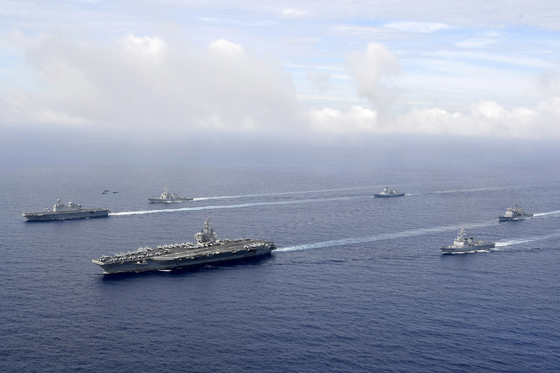
The USS Ronald Reagan carrier strike group is scheduled to arrive at a naval base in Busan on Friday to hold joint maritime drills in the East Sea, said the South Korean Navy in a statement Monday.
The drills will bolster the two countries’ readiness posture and demonstrate the “firm resolve by the Korea-U.S. alliance for the sake of peace and stability on the Korean Peninsula,” it added.
The carrier strike group includes the Nimitz-class Reagan carrier, the USS Chancellorsville guided-missile cruiser and the USS Barry Aegis-equipped destroyer.
The USS Annapolis, a 6,000-ton nuclear-powered submarine, is also expected take part in the drills, according to Korean government sources.
It is unclear if the submarine’s arrival will be acknowledged publicly. In the past, deployments of U.S. nuclear-powered submarines to the Korea area have been carried out secretively or confirmed afterwards.
This exercise comes amid concerns that North Korea is preparing a seventh nuclear test and after its Supreme People’s Assembly adopted a law allowing the use of preemptive nuclear strikes for self-defense earlier this month.
They will be the first such joint drills involving a U.S. aircraft carrier near the Korean Peninsula since October 2017. North Korea conducted its sixth nuclear test in November 2017 and at the time, three U.S. aircraft carriers were simultaneously deployed to the East Sea: the Reagan, Nimitz and Theodore Roosevelt .
In their first bilateral summit in late May, President Yoon Suk-yeol and U.S. President Joe Biden agreed on the deployment of strategic U.S. military assets in “a timely and coordinated manner as necessary” and reaffirmed Washington’s commitment to extended deterrence to Korea “using the full range of U.S. defense capabilities, including nuclear, conventional, and missile defense capabilities.”
They also agreed to expand the “scope and scale” of combined military drills and revived their Extended Deterrence Strategy and Consultation Group (EDSCG).
The deployment of the U.S. carrier strike group is a follow-up to that bilateral summit in May and a defense ministerial meeting in Washington in late July in which Defense Minister Lee Jong-sup and U.S. Secretary of Defense Lloyd Austin agreed to strengthen the alliance’s deterrence posture, including through deploying U.S. strategic assets to the Korean Peninsula.
In a joint statement released after a vice-ministerial meeting of the EDSCG in Washington last Friday, the United States again pledged to “continue to deploy and exercise strategic assets in the region in a timely and effective manner to deter and respond to the DPRK [Democratic People’s Republic of Korea] and enhance regional security.”
The statement described the upcoming deployment of the Ronald Reagan carrier strike group in the region “as a clear demonstration of such U.S. commitment,” adding that the two sides “will continue to explore avenues to enhance Alliance strategic readiness through improved information sharing, training and exercises.”
Earlier this month, Seoul and Washington wrapped up annual summertime combined military exercises that included live fire drills for the first time since 2017.
Other strategic assets such as bombers were scrambled near the Korean Peninsula ahead of the joint maritime exercise in the East Sea, also seen as a demonstration of U.S. extended deterrence.
The U.S. Strategic Command said in a statement Friday that the deployment of B-1B Lancer strategic bombers in the Indo-Pacific region earlier that week is a part of its efforts to “reinforce America’s ironclad commitment to Allies and partners through military employment and demonstrating strategic predictability.”
North Korea has been sensitive to the deployment of U.S. strategic bombers such as the B-1Bs around the Korean Peninsula in the past.
BY SARAH KIM [kim.sarah@joongang.co.kr]




